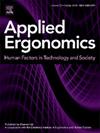Effects of different implementation approaches on the acceptability of a passive exoskeleton for workplace health promotion: An intervention study using the MATE-XT®
IF 3.4
2区 工程技术
Q2 ENGINEERING, INDUSTRIAL
引用次数: 0
Abstract
The aim of this intervention study was to examine the effects of two different implementation approaches of a passive, upper-limb exoskeleton (MATE-XT®) on the acceptability of the exoskeleton by participants and participants’ health in a workplace health promotion setting.
Participants were assigned to one of two groups and underwent either an exoskeleton application training (AT, N = 9) or standardized briefing (SB, N = 9) over a period of 4 weeks. Outcomes of interest, i.e., acceptability of the exoskeleton and participants’ health, were assessed using the Technology Usage Inventory and the Short-Form 12 Health Survey before, immediately after, and approximately one year after the 4-week implementation period. Wearing time was tracked over the 4-week implementation period.
AT participants reported significantly higher usefulness and usability, greater curiosity, reduced skepticism, and had a higher wearing time in the last two weeks of the implementation. In addition, they perceived the exoskeleton as more useful, and reported higher physical health outcomes than SB participants. At one-year-follow-up, AT participants continued to perceive the exoskeleton as more valuable.
不同实施方法对工作场所健康促进被动外骨骼可接受性的影响:使用MATE-XT®的干预研究
本干预研究的目的是检查在工作场所健康促进环境中,被动式上肢外骨骼(MATE-XT®)的两种不同实施方法对参与者外骨骼可接受性和参与者健康的影响。参与者被分配到两组中的一组,在4周的时间内接受外骨骼应用训练(AT, N = 9)或标准化简报(SB, N = 9)。在为期四周的实施期之前、之后和大约一年后,使用技术使用清单和简短的12健康调查来评估感兴趣的结果,即外骨骼的可接受性和参与者的健康。在为期四周的实施期内,追踪佩戴时间。AT参与者报告了显著更高的有用性和可用性,更大的好奇心,更少的怀疑,并且在实施的最后两周有更高的佩戴时间。此外,他们认为外骨骼更有用,并报告了比SB参与者更高的身体健康结果。在一年的随访中,At参与者仍然认为外骨骼更有价值。
本文章由计算机程序翻译,如有差异,请以英文原文为准。
求助全文
约1分钟内获得全文
求助全文
来源期刊

Applied Ergonomics
工程技术-工程:工业
CiteScore
7.50
自引率
9.40%
发文量
248
审稿时长
53 days
期刊介绍:
Applied Ergonomics is aimed at ergonomists and all those interested in applying ergonomics/human factors in the design, planning and management of technical and social systems at work or leisure. Readership is truly international with subscribers in over 50 countries. Professionals for whom Applied Ergonomics is of interest include: ergonomists, designers, industrial engineers, health and safety specialists, systems engineers, design engineers, organizational psychologists, occupational health specialists and human-computer interaction specialists.
 求助内容:
求助内容: 应助结果提醒方式:
应助结果提醒方式:


